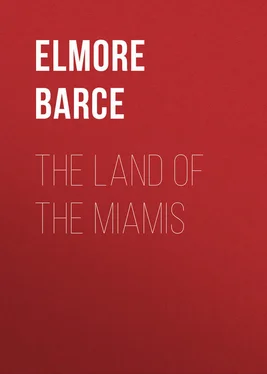Elmore Barce - The Land of the Miamis
Здесь есть возможность читать онлайн «Elmore Barce - The Land of the Miamis» — ознакомительный отрывок электронной книги совершенно бесплатно, а после прочтения отрывка купить полную версию. В некоторых случаях можно слушать аудио, скачать через торрент в формате fb2 и присутствует краткое содержание. ISBN: , Жанр: foreign_antique, foreign_prose, Историческая проза, на английском языке. Описание произведения, (предисловие) а так же отзывы посетителей доступны на портале библиотеки ЛибКат.
- Название:The Land of the Miamis
- Автор:
- Жанр:
- Год:неизвестен
- ISBN:http://www.gutenberg.org/ebooks/30244
- Рейтинг книги:4 / 5. Голосов: 1
-
Избранное:Добавить в избранное
- Отзывы:
-
Ваша оценка:
- 80
- 1
- 2
- 3
- 4
- 5
The Land of the Miamis: краткое содержание, описание и аннотация
Предлагаем к чтению аннотацию, описание, краткое содержание или предисловие (зависит от того, что написал сам автор книги «The Land of the Miamis»). Если вы не нашли необходимую информацию о книге — напишите в комментариях, мы постараемся отыскать её.
The Land of the Miamis — читать онлайн ознакомительный отрывок
Ниже представлен текст книги, разбитый по страницам. Система сохранения места последней прочитанной страницы, позволяет с удобством читать онлайн бесплатно книгу «The Land of the Miamis», без необходимости каждый раз заново искать на чём Вы остановились. Поставьте закладку, и сможете в любой момент перейти на страницу, на которой закончили чтение.
Интервал:
Закладка:
In conversation with his Indian friend Smith happened to say that beavers caught fish. The Indian laughed at him, and told him that beavers ate flesh of no kind, but lived on the bark of trees, roots, and other growing things. "I asked him," said Smith, "if the beaver was an amphibious animal, or if it could live under water? He said that the beaver was a kind of subterraneous water animal, that lives in or near the water, but they were no more amphibious than the ducks and geese were – which was constantly proven to be the case, as all the beavers that are caught in steel traps are drowned, provided the trap be heavy enough to keep them under water. As the beaver does not eat fish, I inquired of Tecaughretanego why the beavers made such large dams? He said they were of use to them in various respects, both for their safety and food. For their safety, as by raising the water over the mouths of their holes, or subterraneous lodging places, they could not be easily found; and as the beaver feeds chiefly on the barks of trees, by raising the water over the banks, they can cut down saplings for bark to feed upon, without going out much upon the land; and when they are obliged to go out upon land for this food they frequently are caught by the wolves. As the beaver can run upon land but little faster than a water tortoise, and is no fighting animal, if they are any distance from the water they become an easy prey to their enemies."
The Indians caught great numbers of beavers by hunting and trapping. In the winter time when they found the beavers in their houses, they first broke up all the thin ice around about, and then by breaking into the houses, drove the beavers into the water. Being soon forced to come to the surface to take the air, the Indians commonly reached in and caught them by the hind legs, dragged them out on the ice and tomahawked them. Not only were the furs and skins utilized, but the flesh as well. Smith describes the meat as being a "delicious fare." In the days before the savages were corrupted by the French and English traders, they possessed a wonderful skill in dressing the skins of the buffalo, the bear and the beaver. Beaver and raccoon skin blankets were made "pliant, warm and durable." Says Heckewelder, the Moravian missionary, "They sew together as many of these skins as are necessary, carefully setting the hair or fur all the same way, so that the blanket or covering be smooth, and the rain do not penetrate, but run off."
In the later days, however, the beaver proved to be more of a curse than a blessing. The Indian then wore the European blanket, and bartered his valuable furs away for whiskey and brandy. The riotous scenes of drunkenness, debauchery and murder became unspeakable. To Detroit the Indians swarmed from the shores of Erie and all the rivers in the interior. Hunting for weeks and months and enduring privation, suffering and toil, they came in at last with their women and children to buy rifles, ammunition and clothing. Here mingled the Miami, the Potawatomi, the Ottawa and the Wyandot; a motley gathering of all the tribes. In the end the result was always the same, and always pitiful. The traders came with the lure of fire water, and when they departed the Indians were left drunken and destitute and often with death, disease and wounds in their midst.
Smith gives a vivid description of one of their orgies at Detroit as follows: "At length a trader came to town (the Indian camp) with French brandy. We purchased a keg of it, and held a council about who was to get drunk, and who was to keep sober. I was invited to get drunk, but I refused the proposal. Then they told me I must be one of those who were to take care of the drunken people. I did not like this, but of the two evils I chose that which I thought was the least, and fell in with those who were to conceal the arms, and keep every dangerous weapon we could out of their way, and endeavor, if possible, to keep the drinking club from killing each other, which was a very hard task. Several times we hazarded our lives, and got ourselves hurt, in preventing them from slaying each other. Before they had finished the keg, near one-third of the town was introduced to this drinking club; they could not pay their part, as they had already disposed of all their skins; but they made no odds, all were welcome to drink."
"When they were done with the keg, they applied to the traders, and procured a kettle full of brandy at a time, which they divided out with a large wooden spoon – and so they went on and on and never quit whilst they had a single beaver skin. When the trader had got all our beaver, he moved off to the Ottawa town, about a mile above the Wyandot town."
"When the brandy was gone, and the drinking club sober, they appeared much dejected. Some of them were crippled, others badly wounded. A number of the fine new shirts were torn, and several blankets burned. A number of squaws were also in this club, and neglected their corn planting."
"We could now hear the effects of the brandy in the Ottawa town. They were singing and yelling in the most hideous manner, both night and day; but their frolic ended worse than ours; five Ottawas were killed, and a great many wounded."
The marshes, lakes, rivers and small streams of northern Ohio and Indiana, and of the whole of Michigan and Wisconsin, abounded with the homes and habitations of the beavers. Behind them, as a memorial of their old days, they have left the names of creeks, towns, townships and even counties. The beaver lake region of northern Indiana has a Beaver "lake," a Beaver "township," a Beaver "creek," a Beaver "city," and a Beaverville to its credit. The history of Vigo and Parke counties, Indiana, by Beckwith, Chapter Twenty, at page 208, recites that beavers existed along all the small lakes and lesser river courses in northern Indiana, They were plentiful in Dekalb, Marshall, Elkhart, Cass. White and Steuben. It is well known that their dams existed in large numbers in Newton and Jasper, and in practically all the Indiana counties north of the Wabash river.
The above regions, with their wealth of peltries, England meant to hold as long as possible against the American advance, and she succeeded in doing so for twelve long years after the Revolution had closed.
CHAPTER IV
THE PRAIRIE AND THE BUFFALO
– The buffalo as the main food supply of the Indians.
To describe all the wonders in the interior of the northwest would be a serious, if not an impossible task. The Grand Prairie, however, stands alone. It was one of the marvels of creation, resembling the ocean as nothing else did, making men who saw, never forget.
On Sunday, the third day of November, 1811, General Harrison's army, with scouts in front, and wagons lumbering along between the flanks, crossed the Big Vermilion river, in Vermilion County, Indiana, traversed Sand Prairie and the woods to the north of it, and in the afternoon of the same day caught their first glimpse of the Grand Prairie, in Warren County, then wet with the cold November rains. That night they camped in Round Grove, near the present town of Sloan, marched eighteen miles across the prairie the next day, and camped on the east bank of Pine creek, just north of the old site of Brier's Mills. To the most of them, the sight must have been both novel and grand; if they could have known then that the vast undulating plain before them stretched westward in unbroken grandeur, a distance of two hundred and fifty miles to the Mississippi river at Quincy; that these vast possessions in a few short years would pass from the control of the savage tribes that roamed over them, and would become the future great granaries of the world, producing enough cereals to feed an empire, what must have been their thoughts?
The magnitude of this great plain, now teeming with thousands of homes and farms, is seldom realized. Draw a straight line west from old Fort Vincennes to the Mississippi, and practically all north of it, to the Wisconsin line, is the Grand Prairie. "Westward of the Wabash, except occasional tracts of timbered lands in northern Indiana and fringes of forest growth along the intervening water courses, the prairies stretch westward continuously across Indiana, and the whole of Illinois to the Mississippi. Taking the line of the Wabash railway, which crosses Illinois in its greatest breadth, and beginning in Indiana, where the railway leaves the timber, west of the Wabash near Marshfield (in Warren County), the prairie extends to Quincy, a distance of more than two hundred and fifty miles, and its continuity the entire way is only broken by four strips of timber along four streams running at right angles with the route of the railway, namely, the timber on the Vermilion river between Danville and the Indiana state line; the Sangamon, seventy miles west of Danville, near Decatur; the Sangamon again a few miles east of Springfield, and the Illinois river at Meredosia, and all the timber at the crossing of these several streams, if put together, would not aggregate fifteen miles, against the two hundred and fifty miles of prairie. Taking a north and south direction and parallel with the drainage of the rivers, one could start near Ashley, on the Illinois Central railway, in Washington county, and going northward, nearly on an air line, keeping on the divide between Kaskaskia and Little Wabash, the Sangamon and the Vermilion, the Iroquois and the Vermilion of the Illinois, crossing the latter stream between the mouths of the Fox and DuPage, and travel through to the state of Wisconsin, a distance of nearly three hundred miles, without encountering five miles of timber during the whole journey."
Читать дальшеИнтервал:
Закладка:
Похожие книги на «The Land of the Miamis»
Представляем Вашему вниманию похожие книги на «The Land of the Miamis» списком для выбора. Мы отобрали схожую по названию и смыслу литературу в надежде предоставить читателям больше вариантов отыскать новые, интересные, ещё непрочитанные произведения.
Обсуждение, отзывы о книге «The Land of the Miamis» и просто собственные мнения читателей. Оставьте ваши комментарии, напишите, что Вы думаете о произведении, его смысле или главных героях. Укажите что конкретно понравилось, а что нет, и почему Вы так считаете.












